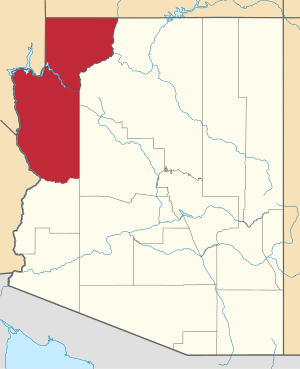Oatman, Arizona
Oatman is a village in the Black Mountains of Mohave County, Arizona, located at an elevation of 2,710 feet (830 m). It began as a small mining camp when two prospectors struck a $10 million gold find in 1915, though the vicinity had already been settled for a number of years. Oatman's population grew to more than 3,500 in the course of a year.
Oatman, Arizona | |
|---|---|
Unincorporated community | |
 Oatman Highway/Old US 66 to Oatman | |
 Location of Oatman in Mohave County, Arizona | |
 Oatman, Arizona Location of Oatman in Mohave County, Arizona | |
| Coordinates: 35°01′35″N 114°23′01″W | |
| Country | United States |
| State | Arizona |
| County | Mohave |
| Named for | Olive Oatman |
| Area | |
| • Total | 0.19 sq mi (0.50 km2) |
| • Land | 0.19 sq mi (0.50 km2) |
| • Water | 0.00 sq mi (0.00 km2) |
| Elevation | 2,710 ft (826 m) |
| Population (2010) | |
| • Total | 128 |
| • Estimate (2016)[3] | N/A |
| Time zone | UTC-7 (MST (no DST)) |
| FIPS code | 04-50620 |
History
The name Oatman was chosen in honor of Olive Oatman, a young Illinois girl who was captured and enslaved by an Indian tribe during her pioneer family's journey westward in 1851. She was later traded to the Mohave tribe, who adopted her as a daughter and tattooed her face in the custom of the tribe. She was released in 1856 at Fort Yuma.[4]
In 1863, prospector Johnny Moss discovered gold in the Black Mountains and staked several claims, one named the Moss after himself and another after Olive Oatman, whose story was well known. For the next half-century, mining waxed and waned in the remote district until new technology, reduced transportation costs, and new gold discoveries brought prosperity to Oatman in the early 20th century. The opening of the Tom Reed mine, followed by the discovery of a rich ore body in the nearby United Eastern Mining Company's property in 1915, brought one of the desert's last gold rushes. The boom of 1915–17 gave Oatman all the characters and characteristics of any gold rush boomtown. For about a decade, the mines of Oatman were among the largest gold producers in the American West.[5]
In 1921, a fire burned down many of Oatman's smaller buildings, but spared the Oatman Hotel built in 1902. It remains the oldest two-story adobe structure in Mohave County and a Mohave County historical landmark. It is especially famous as the honeymoon stop of Clark Gable and Carole Lombard[6] after their wedding in Kingman, Arizona on March 18, 1939. Gable fell in love with the area and returned often to play poker with the miners. The Gable-Lombard honeymoon suite is one of the hotel's major attractions.

In 1924, the town's main employer United Eastern Mines permanently shut down its operations after producing $13,600,000 worth of gold (equivalent to $202,891,000 in 2019) at the government-controlled market value of $20 per ounce. The district had produced $40 million (equivalent to $695,294,000 in 2019) in gold by 1941, when the remainder of the town's gold mining operations were ordered shut down by the government as part of the country's war effort, since other metals were needed. Oatman was fortunate it was located on busy U.S. Route 66 and was able to cater to travelers driving between Kingman, Arizona, and Needles, California. Yet even that advantage was short-lived, as the town was completely bypassed in 1953 when a new route was built between Kingman and Needles. By the 1960s, Oatman was all but abandoned.
 Oatman Jail established in 1936
Oatman Jail established in 1936 The Olive Oatman Restaurant and Saloon
The Olive Oatman Restaurant and Saloon Fast Fanny's Place a former brothel
Fast Fanny's Place a former brothel The Oatman Drug Company Building built 1915 and listed in the NRHP
The Oatman Drug Company Building built 1915 and listed in the NRHP Oatman Hotel, originally the Durlin Hotel, built in 1902
Oatman Hotel, originally the Durlin Hotel, built in 1902 Mines and mills of the Oatman district, c. 1921
Mines and mills of the Oatman district, c. 1921
See also
References
- "2016 U.S. Gazetteer Files". United States Census Bureau. Retrieved July 18, 2017.
- U.S. Geological Survey Geographic Names Information System: Oatman
- "Population and Housing Unit Estimates". Retrieved June 9, 2017.
- The Blue Tattoo, the Life of Olive Oatman, by Margot Mifflin, 2009 ISBN 978-0803235175
- Paher, Stanley (1980). Northwestern Arizona Ghost Towns. Las Vegas: Nevada Publications. pp. 24–31. ISBN 0-913814-30-X.
- Varney, Philip (April 2005). "Mohave Ghosts". In Stieve, Robert (ed.). Arizona Ghost Towns and Mining Camps: A Travel Guide to History (10th ed.). Phoenix, Arizona: Arizona Highways Books. p. 39. ISBN 1-932082-46-8.
Further reading
External links
| Wikimedia Commons has media related to Oatman, Arizona. |
| Wikivoyage has a travel guide for Oatman. |
- Oatman and Gold Road Chamber of Commerce - Information and events
- Oatman at Ghost Town Gallery
- Oatman at Western Mining History
